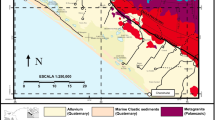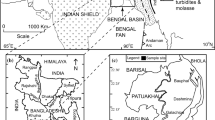Abstract
Quartz sand grains obtained from a deeply gullied topography along the banks of two tributaries of River Pravara in Godavari Basin, Maharashtra have been examined with a scanning electron microscope (SEM) in order to make the environmental interpretations of these deposits. The sediments reveal features resulting from mechanical grinding as well as from chemical alteration. Conchoidal fractures, cleavage planes, grooves, v-shaped indentations etc are the mechanical features documented on the grains whereas solution pits of varying sizes and intensity, precipitation surfaces, oriented v-pits, solution crevasses and etching are the features of diagenetic origin. Few sand grains show the evidence of wind transported sediments. Several evidence indicate that the samples have undergone digenetic changes. Few grains exhibit the features of intense chemical breakdown. The overall assemblages of the grain surface features suggest that the samples have been subjected to subaqueous transport for a considerable period of time. The chemical features such as etching, solution pits or semi circular arcuate steps that are found in abundance in these grains are due to the dissolution of the sediments in a low energy fluviatile environment, such as in floodplain region.
Similar content being viewed by others
References
Babu, N., Sundarajan, M., Suresh Babu, D.S. and Mohan Das, P.N. (2007) Characterisation studies of ilmenite through XRD and SEM examination, Proceeding volume on International conference on advanced materials and composites, Scribd, pp.1028–1038.
Bull, P.A. (1981) Environmental reconstruction by electron microscopy. Progress in Physical Geography, v.5(3) pp.368–397.
Carver, R.E. (Ed.) (1971) Procedures in sedimentary petrology, JohnWiley and Sons, New York, 653p.
Culver, S.J., Bull, P.A., Campbell, S., Shakesby, R.A. and Whalley, W.B. (2006) Environmental discrimination based on quartz grain surface textures: a statistical investigation. Sedimentology, v.30(1), pp.129–136.
Doorncamp, J.C. (1974) Tropical weathering and ultra-microscopic characteristics of regolith quartz on Darmoor. Geographiska Annaler, v.56A, pp.73–82
Jimin, S., Sheng-Hua Li, Han, P. and Chen, Y. (2005) Holocene environmental changes in the central Inner Mongolia, based on single-aliquot-quartz optical dating and multi-proxy study of dune sands, Palaeogeo., Palaeoclimat. Palaeoeco., v.233(1–2), pp.51–62.
Joshi, V.U. and Kale, V.S. (1997) Colluvial deposits in northwest Deccan, India: their significance in the interpretation of late Quaternary history. Jour. Quaternary Sci., v.12, pp.391–403.
Kale, M.G. (1996) Quaternary sedimentation history of central Narmada valley around Jabalpur, Madhya Pradesh. An unpublished Project report by DST.
Kale, V.S. and Rajaguru, S.N. (1987) Late Quaternary alluvial history of the northwestern Deccan Upland region. Nature, v.325, pp.612–614.
Kleesment, A. (2009) Roundness and surface features of quartz grains in middle Devonian deposits of East Baltic and their palaeogeographic implications. Estonian Jour. Earth Sci., v.58(1), pp.71–84.
Krinsley, D.H. and Doorncamp, J.C (1973) Atlas of Quartz sand grain surface textures. Cambridge Univ. Press.
Madhavaraju, J., LE Yong Il, Armstrong-Altrin J.S. and Hussain, S.M. (2006) Microtextures on detrital quartz grains of upper Maastrichtian-Danian rocks of the Cauvery Basin, Southeastern India: implications for provenance and depositional environments Geosciences Jour., v.10, pp.23–34.
Mahaney W.C. (2002) Atlas of sand grain surface textures and applications. Oxford University Press, New York.
Matthias, B. and Kari, B. (2005) Provenance Analysis by Single-Quartz-Grain SEM-CL/Optical Microscopy, Jour. Sedimen. Res., v.75(3), pp.492–500.
PETIJOHN, E. J, (1984) Sedimentary rocks, CBS publishers and distributors, Delhi, 628p.
Tiwari, G.S, Tiwari, R.N. and Singh, K.N. (2001) Architecture of geomorphic surfaces associated with migration and confluence of Ganga and Yamuna river channels, Allahabad, U.P. Geol. Surv. India. Spec. Publ. No.65 (iii), pp.147–152
Tiwari, G.S, Tiwari, R.N. and Singh, K.N. (2004) SEM surface microtextures of quartz grains from Ganga and Yamuna river sediments, Allahabad, U.P. Jour. Geol. Soc. India, v.63, pp.515–521.
Author information
Authors and Affiliations
Corresponding author
Rights and permissions
About this article
Cite this article
Joshi, V.U. Grain surface features of alluvial sediments of upper Pravara Basin and their environmental implications. J Geol Soc India 74, 711–722 (2009). https://doi.org/10.1007/s12594-009-0188-4
Received:
Accepted:
Published:
Issue Date:
DOI: https://doi.org/10.1007/s12594-009-0188-4




